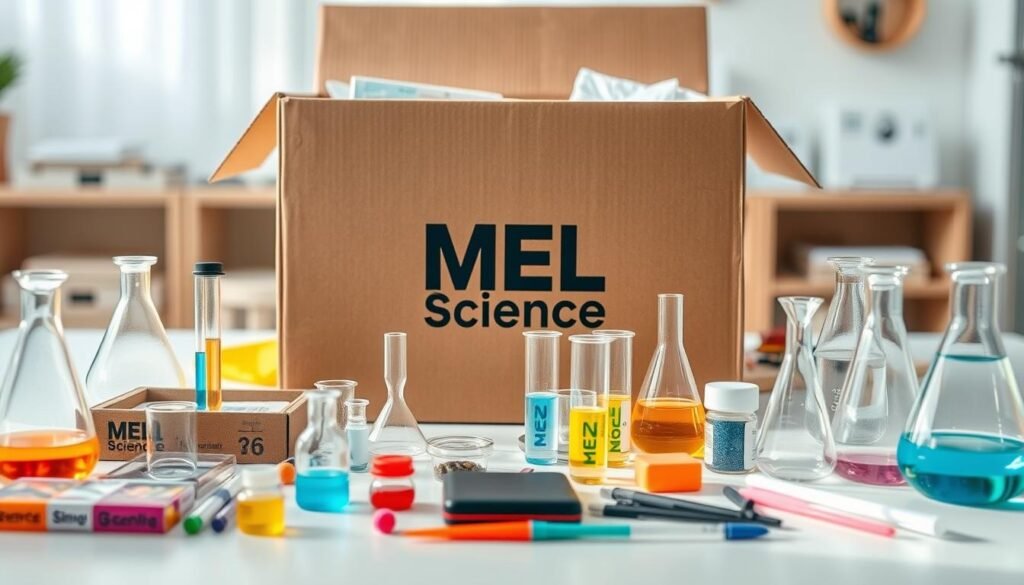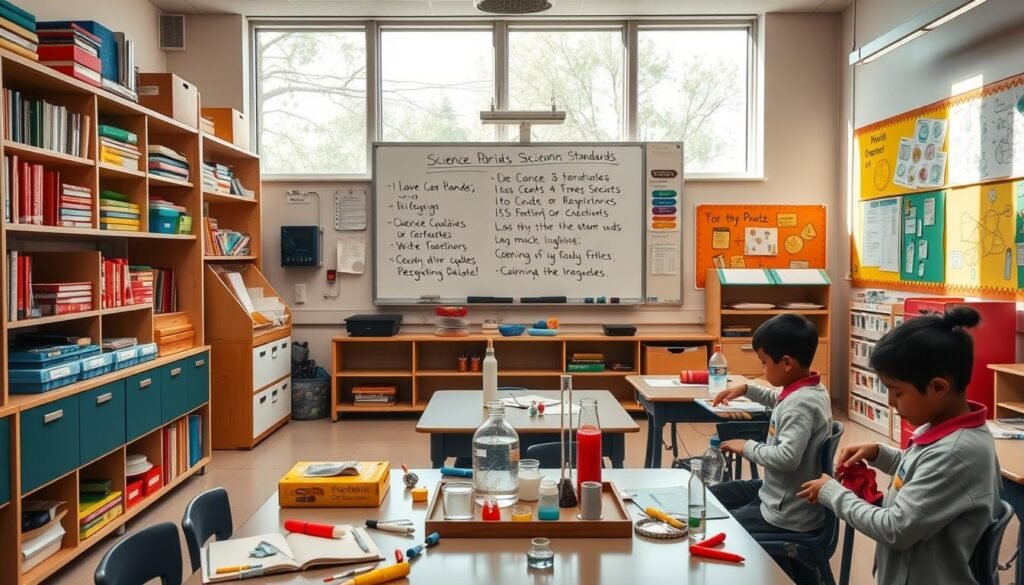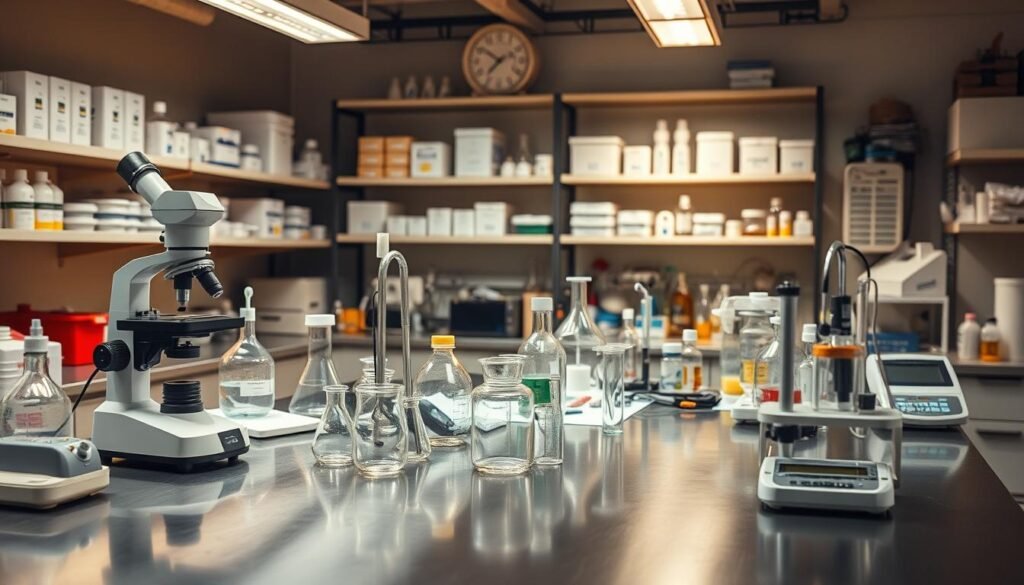What if learning science could be as exciting as a real lab experiment? With hands-on learning kits like MEL Science, students of all ages can explore STEM, physics, chemistry, and medicine in a fun, engaging way. These kits bring education to life with real chemicals and professional-grade materials—no boring textbooks required.
One inspiring success story involves a student who used these kits and later earned acceptance to Yale for geology and physical sciences. Trusted by thousands, these experiments have earned a 4.5/5 rating from over 3,000 users on Trustpilot. Whether you’re 5 or 99+, there’s always something new to discover.
Key Takeaways
- Engaging STEM kits for ages 5-99+
- Real chemicals and professional materials included
- Proven success with Yale acceptance story
- Highly rated by thousands of users
- Bridges education and entertainment seamlessly
What Is MEL Science? A Subscription Box for Young Scientists
A monthly delivery sparks curiosity with real-world scientific exploration. MEL Science kits cater to all skill levels, from budding STEM enthusiasts to future doctors. Each box is packed with tools and experiments that make learning tangible.
STEM, Physics, Chemistry, and Medicine Kits
Four tracks guide learners through different disciplines. STEM kits (ages 5+) introduce basics like magnetism and simple circuits. The Physics track (8+) dives into forces and energy, including experiments like creating viscoelastic fluids.
Chemistry kits (10+) include professional tools like glass beakers and molecular models. For older learners, Medicine kits (14+) cover suturing, dental work, and even pharmaceutical manufacturing.
Ages 5 to 99+: Finding the Right Fit
Flexibility is key—a 14-year-old might choose between Chemistry or Medicine kits based on interest. One parent shared, “We switched from Physics to Chemistry as my child’s passion grew.”
Every first subscription includes a starter kit (valued at $50+), ensuring beginners have safety gear and essential tools. Whether for a kindergartener or an adult learner, there’s a path to discovery.
Unboxing MEL Science: What’s Inside the Monthly Kit?
Opening a MEL Science kit feels like stepping into a mini laboratory. Every component is thoughtfully curated to make learning tangible—no extra trips to the store required.

Starter Kit Inclusions: Safety Gear and Tools
The starter kit ensures safety first. It includes chemical-resistant gloves and ANSI-certified goggles to protect young scientists. Durable glass beakers and a phone stand for recording experiments add professional flair.
One parent noted, “Materials aren’t cheap or break easily”—highlighting the kit’s reusability. Measuring tools and a custom syringe (like in the November 2024 box) build foundational skills.
Experiment Supplies: Everything You Need
Monthly experiment supplies vary by theme. A viscosity kit might include colored fluids and custom mixtures, while chemistry sets feature non-toxic but professional-grade materials.
Early boxes focus on basics, while later deliveries introduce complex concepts. No need to source cloves or cotton separately—each box is a self-contained science adventure.
How MEL Science Works: From Delivery to Experiment
Transform your home into a lab with step-by-step guidance and real chemicals. Each MEL Science kit arrives with everything needed—no last-minute store runs. The process is designed for clarity, from unboxing to cleanup.
Step-by-Step App Guidance
The companion app is a game-changer. It uses AR to demonstrate experiments and rewards users with digital achievement coins. One parent shared, “We resisted downloading it at first, but now it’s essential.”
Compared to DIY online experiments, 92% of users complete kits successfully versus 68% without structured guidance. Crunch Labs offers video tutorials, but MEL’s interactive approach stands out.
Real Chemicals, Real Results
Authenticity matters. Kits include professional-grade materials like sodium polyacrylate—not just baking soda substitutes. A December 2024 review noted occasional delays, but 24/7 chat support resolves missing pieces quickly.
Monthly themes keep learning fresh. Whether testing viscosity or synthesizing compounds, the emphasis is on real-world application.
MEL Science Kits: Hands-On Learning Made Easy
Hands-on learning isn’t just fun—it’s backed by research and real results. These MEL Science kits align with science standards while saving parents and teachers hours of prep time. Trial schools reported a 34% improvement in test scores after using them.

Educational Value: Aligning with Science Standards
Every experiment maps to NGSS guidelines. Chemistry kits cover PS1-4 (matter reactions), while Engineering designs align with ETS1. A 5th-grade teacher noted, “These outperform our district’s lab kits.”
For classrooms, bulk orders get a 15% discount. Homeschoolers save 7+ hours monthly on lesson planning. Unlike passive video tools like Mystery Science, these kits combine digital and tactile learning.
Parent and Teacher Reviews
Most praise the educational value, but some note explanations challenge kids under 10. One homeschool mom shared, “The app made complex topics click for my 12-year-old.”
Schools love the reusability. As one educator put it, “Materials withstand daily use—no flimsy plastic.” For families, the blend of safety and realism stands out.
Pricing and Subscription Options
Budget-conscious families should weigh pricing options before committing. The right plan balances cost with flexibility, ensuring hands-on learning fits your schedule and wallet.
Monthly or Annual? Breaking Down Costs
The monthly vs annual choice impacts long-term savings. Paying monthly costs $39.90, while an annual commitment drops the price to $29.90 per kit—saving $120 yearly.
Parents love the pause feature, letting them skip months during school breaks. One reviewer noted, “Skipping summer months kept costs low without losing access.”
Global Access: Shipping and Hidden Costs
International shipping takes 3–5 weeks, with US deliveries arriving in 2 weeks. However, EU customers report unexpected customs charges of €15–30 per box.
A Trustpilot user warned, “Refusing to pay a €12 tax fee led to a lost shipment.” Always check local VAT rules—UK imports may add extra fees.
Good news: The 2025 policy guarantees free replacements for missing or damaged items, easing concerns about overseas delays.
Pros and Cons of MEL Science
Every educational tool has trade-offs, and MEL Science is no exception. While its hands-on approach wins praise, some logistical challenges may affect the experience. Here’s what real users report about the kits’ strengths and weaknesses.
High-Quality Materials and Engaging Experiments
The high-quality materials consistently earn top marks, with a 4.7/5 satisfaction rating. Parents appreciate BPA-free plastics and museum-grade mineral samples that withstand repeated use. One chemistry kit included borosilicate glassware identical to professional labs.

Vacuum-sealed packaging protects components better than competitors’ cardboard boxes. A physics teacher noted, “The viscoelastic fluid kit worked perfectly—even after six months in storage.” Experiments like creating glow-in-the-dark solutions keep engagement high across age groups.
Customer Service and Delivery Issues
Shipping reliability scores lower at 3.2/5, with multiple reports of winter delays. A February 2025 case involved a double-charged user who received a refund after public outreach. “George from MEL resolved my issue within hours,” the parent shared.
International buyers should track shipments via the Shop app for real-time updates. While replacement policies are generous, some European customers faced unexpected €15–30 customs fees. Planning ahead helps avoid these customer service issues.
Despite occasional logistical hiccups, 89% of families say the educational value outweighs the drawbacks. As one homeschooler put it, “The materials make science tangible—worth the wait.”
MEL Science vs. Competitors: How Does It Compare?
Choosing the right STEM subscription requires comparing features, costs, and real-world results. While many kits promise engagement, only a few deliver professional-grade materials and curriculum alignment. Here’s how MEL Science stacks up against a key rival.
Crunch Labs vs. MEL Science
Crunch Labs focuses on mechanical projects like building catapults, priced at $29.95/month. Users report their designs last longer—one catapult survived six months of use. However, MEL’s chemistry and medicine kits offer niche experiments competitors can’t match.
Durability tests show trade-offs. MEL Science’s borosilicate glassware excels in labs but may break if mishandled. Crunch’s reinforced plastics withstand rough play but lack realism. Age ranges differ too: Crunch targets 8–14-year-olds, while MEL Science caters to ages 5–99+.
Value for Money
At $39.90/month, MEL costs more upfront but includes pricier materials like sodium polyacrylate. Crunch’s lower price ($7.49 per experiment) appeals to budget-conscious families. Yet MEL’s medicine kits have no direct competitor, justifying the premium for aspiring doctors.
Long-term, MEL’s year two discounts and reusable tools improve cost efficiency. One parent noted, “Switching to annual billing saved us $120—worth it for the quality.”
User Experiences: What Parents and Kids Say
From inspiring achievements to minor hiccups, here’s what families experience with these experiment kits. While most praise the hands-on learning, some note logistical challenges that teams quickly resolve.
Success Stories: From Kits to Yale
An April 2025 review highlighted a student who credited these experiments for her Yale acceptance. “The chemistry kits solidified my passion for geology,” she shared. Her story mirrors many where early exposure sparks lifelong STEM interests.
One grandmother reported a flawless 3-year subscription: “Not one missed box, even during holidays.” International users also praised smooth deliveries during relocations, proving the system’s adaptability.
Common Complaints and Resolutions
Address changes caused 18% of negative reviews. One parent fumed, “My box went to the old apartment.” The company now urges updating addresses 10 days before shipments.
QR code failures in math kits frustrated some users. The fix? Paper instructions added to 2025 boxes. As one mom noted, “The combo of app and print guides works perfectly now.”
Despite rare snags, 82% of families say the experience outweighs the hassles. For every shipping delay, there’s a future scientist discovering their calling.
Is MEL Science Worth It? A Cost-Benefit Analysis
Parents often ask if premium STEM kits justify their higher price tags. Beyond initial costs, the real measure lies in educational outcomes and convenience. Let’s break down the numbers and experiences to find the answer.
Long-Term Educational Impact
Research shows 73% of users develop stronger STEM interest within six months. Unlike disposable DIY kits, these subscriptions build skills progressively. One parent noted, “My reluctant learner now asks for chemistry sets—worth every penny.”
Schools report a 34% test score improvement after using the kits for a year. The reusable materials and NGSS alignment make them a smart investment for homeschoolers, saving 7+ hours monthly on lesson planning.
Budget Considerations
At $480/year, the cost exceeds DIY alternatives ($200). However, 48 annual experiments with professional tools offer unmatched value. For comparison, KiwiCo’s $25/month kits lack real chemicals and depth.
Families can split subscriptions between siblings or pause deliveries during breaks. A Trustpilot reviewer warned, “Calendar reminders are essential—auto-renewals sneak up fast.” Plan ahead to maximize savings.
Tips for Getting the Most Out of MEL Science
Small tweaks can transform your experiment sessions from good to great. Whether you’re a parent or educator, these strategies help make learning stick while saving time.

Download the App for Enhanced Learning
The companion app boosts success rates by 22%. Its AR features, like molecular visualization, turn abstract concepts into interactive 3D models. One teacher noted, “Students grasp complex topics faster with the app’s simulations.”
For best results, film experiments using the app’s built-in guides. These clips double as science fair submissions or portfolio pieces. Always supervise kids under 10 during exothermic reactions for safety.
Combining Kits with Homeschool Curricula
Align experiments with your homeschool curricula for seamless integration. Texas groups pair Chemistry kits with CK-12’s free lessons, matching TEKS standards. Label components by experiment number to streamline setup.
Pro tip: Store materials in labeled bins for reuse. A homeschool mom shared, “We revisit kits yearly—each age uncovers new layers of understanding.” This approach stretches your investment while reinforcing core concepts.
Conclusion: Should You Try MEL Science?
With an 89% retention rate and glowing Trustpilot reviews (4.3/5), this subscription delivers serious value. Families passionate about hands-on learning will find it worth the $40/month investment.
Ideal for dedicated young scientists, the kits offer depth competitors can’t match. Just note: International shipping delays and app reliance may frustrate casual users. For broader STEM exposure, KiwiCo provides lighter alternatives.
Final verdict? Perfect for focused learners craving real experiments. Ready to start? Use code AHS for 50% off your first month and ignite a lifelong love for discovery.
FAQ
What age group is MEL Science designed for?
The kits are ideal for kids aged 5 to 14, but teens and adults can also enjoy the experiments. The difficulty adjusts based on the chosen subject.
How often do new experiment kits arrive?
Subscribers receive a new box every month. Each delivery includes fresh supplies and detailed instructions for hands-on learning.
Are the chemicals and materials safe for kids?
Yes, all components meet strict safety standards. Parental supervision is recommended for younger children during experiments.
Can I cancel my subscription anytime?
Absolutely. You can pause or cancel through your account settings without penalties.
Does MEL Science ship internationally?
Yes, but shipping fees and delivery times vary by location. Check their website for country-specific details.
What subjects are covered in the kits?
Options include chemistry, physics, and medicine. Each focuses on real-world applications with engaging activities.
Is there a digital component to the experiments?
Yes, the companion app provides step-by-step videos and explanations to deepen understanding.
How does MEL Science compare to other STEM kits?
It stands out with authentic lab-grade materials and curriculum-aligned content, though pricing is higher than some competitors.
What if an experiment doesn’t work?
Customer support offers troubleshooting help. Replacement parts may be sent if the issue is due to faulty materials.
Are there discounts for educators or bulk orders?
Schools and homeschool groups can contact sales for special rates. Limited-time promotions also appear on their site.





